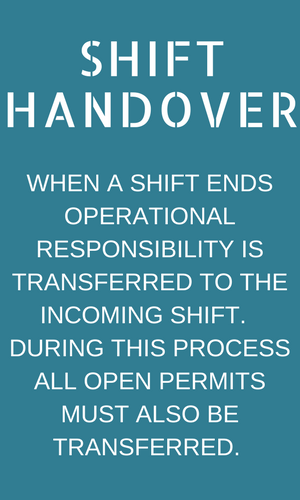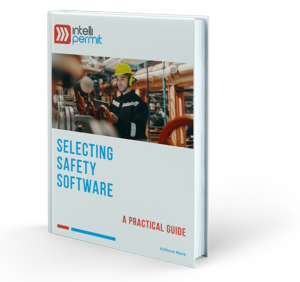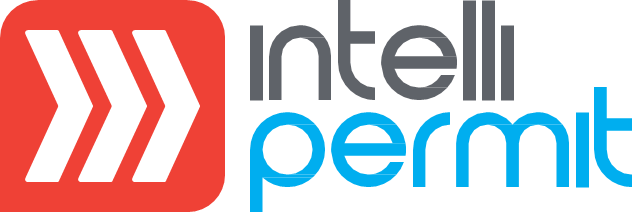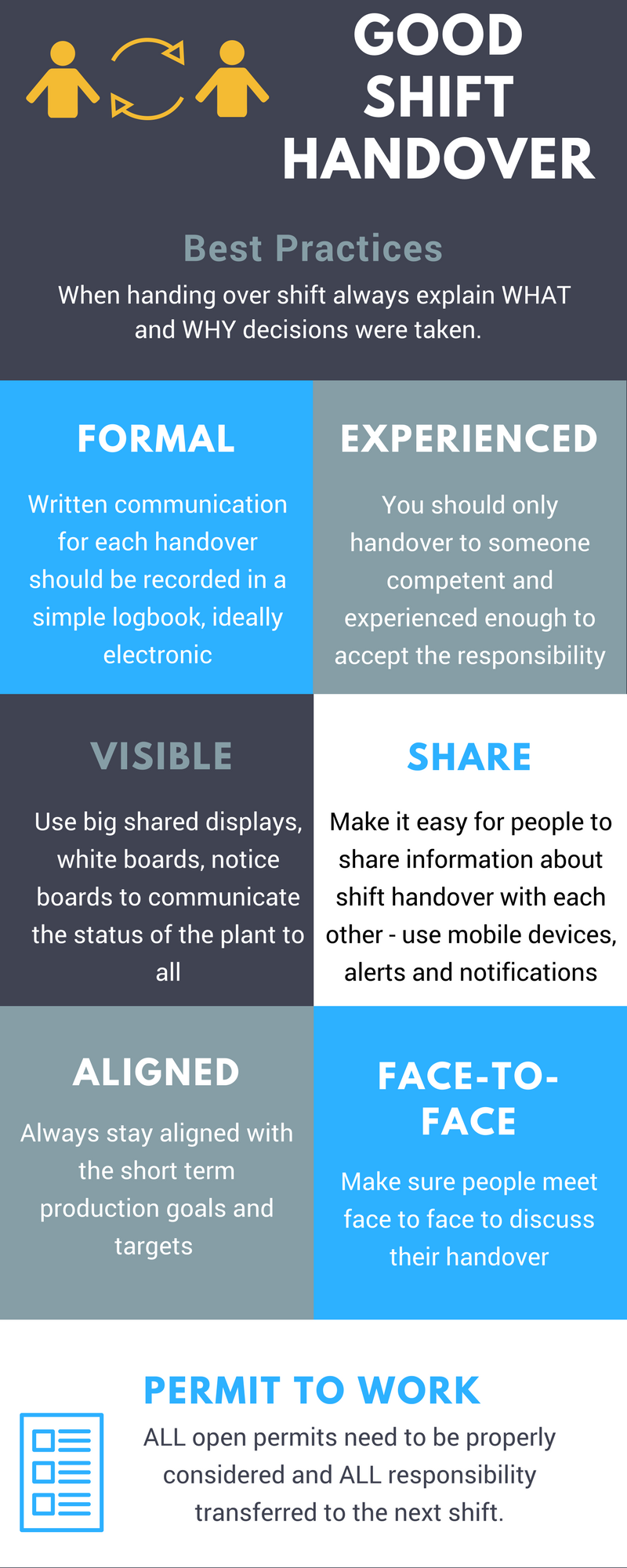Shift handover and the permit to work
Good communication between teams working on plants is an important contributor to safety.
When a team hands over responsibility to another (as takes place during shift handover) there is always the possibility of an important detail being overlooked.
The handover process relies on good communication to ensure continuity. Any weakness in this communication can introduce safety risk. The result might be a serious accident that could have been avoided.
Shift handover
Changing shifts is a requirement in any continuous process. While plants can operate 24X7, people need to take breaks. Shift handover should be regarded as a high-risk process because it cannot be automated and relies on human behavior. The goal of the handover process is to maintain continuity and the formal transfer of responsibility and accountability between the respective parties.
Work that takes place across shifts
A shift roster is typically set up in advance to accommodate the need for people to work to a schedule. Shift changeover times are planned in advance. The reality of day to day operations is that certain tasks like critical repairs, or unloading bulk raw materials happen on their own time scale. These tasks, sometimes involving different teams can take place during two or more shifts. Other, bigger tasks such as a major repair might take place over days, weeks or even months.
Shift handover procedure
To ensure continuity and minimize errors, a standard procedure is implemented for shift handover. Each company will develop their own procedure in line with their operational requirements. In practice we have observed that there is little standardization of these handover procedures between companies, and while some follow a very rigorous and defined process, others merely rely on individuals to communicate effectively.
Risks associated with shift handover
Considering that a typical shift is either 8 or 12 hours long, changeover happens 1095 or 730 times during the year, in other words there are 730 or 1095 high risk opportunities for miscommunication leading to safety incidents. Making sure that the changeover process itself is defined and managed properly is a priority area to focus on when looking for ways to improve safety on the plant.
Several studies into shift handover have been done to better understand ways to improve the procedures. One such HSE study analysed a number of incidents involving planned maintenance work and found that the following shift handover related risks were contributing factors to accidents and fatalities [1]:
- In some of the incidents, planned maintenance work continued over a shift change.
- Thorough [coordination and] communication of such work should be afforded a very high priority.
- Operator support [logs] were not designed to capture key information reliably and unambiguously.
- A lack of procedures which specified how to conduct an effective shift handover was evident.
- Inaccurate and unreliable carry-forward of written information from shift to shift was evident. For example, reference to a temporary safety system over-ride was not carried forward.
The permit to work and shift handover
In typical industrial environments the permit to work makes sure that communication takes place between all people involved in dangerous, non-routine tasks on the plant.
So, what should happen to these permits at shift handover?
Two approaches are possible:
- The permit is closed off and a new permit issued by the incoming shift for the work to continue.
- A shift handover procedure is implemented that ensures that responsibility is transferred from the outgoing to the incoming persons on the permit document itself.
The first approach takes more time but forces a fresh review of the job and helps ensure that communication takes place. The second approach is more streamlined but runs the risk that something important has changed that is not adequately interrogated by the responsible persons at changeover.
In practice there is often confusion as to which of the two approaches is best within a single company, and the procedures also differ between industries. Unsurprisingly for example, in the nuclear industry a much more structured handover process is followed than for example in chemicals manufacturing.
The HSE study [1] also found an interesting disconnect. In a survey of chemicals plant personnel, the majority of fitters and superintendents were of the view that a new permit should be issued at changeover, while the majority of managers believed that the work should carry on using the same permit. This lack of alignment should be of concern as it seems as there is scope for confusion.

Article by Gavin Halse and Henry Boshoff
Free Guide - Selecting Safety Software

Learn why safety management software is necessary to support a modern industrial operation, the different types of software applications, and helpful, practical advice on how to undertake a safety software selection process in your own company.
Get started today, download your guide and take the next step towards world-class safety management.
What constitutes a good shift handover procedure?
A good shift changeover procedure should be based on the following design principles:
- Formal written communication around each handover should be documented in a simple, secure, structured logbook, ideally electronic.
- Information between shifts should also communicate the “why” and not just the “what”.
- Information between shifts should be communicated between experienced competent persons who understand the process and work being done.
- Relevant information should be highly visible to all affected – e.g. displays around the plant, mobile devices, etc.
- Relevant focused shift and safety information should be easily shared.
- The handover process should always be aligned to the short and medium-term production goals and targets and these need to be visible.
- Coordination and linking of all the other relevant processes underway – such as any open permits, isolations and so on. The information should ideally be in a common system or database.
- Face to face communication between role-players.
- Catering for regular handover and / or production meetings that result in tasks being assigned, followed up and shared in a management system.
- Support for continuous training and audit of the processes.
Electronic shift handover and permit systems
Computer systems like IntelliPERMIT are used in many organisations to help manage operational safety. A few of these systems incorporate the shift changeover process. When considering an electronic permit to work system, it is important to check that the system can accommodate the overall operation and does not just focus on one single process in isolation.
How IntelliPERMIT supports shift changeover and permits
IntelliPERMIT has been designed with operations excellence and productivity in mind, as well as minimizing operational risk. Over many years the system has evolved beyond an electronic permit to work system to accommodate the various processes that take place in the plant, including shift handover.
Here are some of the ways IntelliPERMIT supports the interaction taking place at shift handover and permit to work:
1. New signatories on the permit
IntelliPERMIT supports transfer of responsibility between the responsible people named on the permit by appending the signatures of the outgoing and incoming individuals at shift changeover. These individuals have to review the permit in order to sign, and the system has a dual signature feature that can be set up to force simultaneous signatures (at the same computer terminal).
2. Incorporating your business rules
IntelliPERMIT is built on a set of “business rules” that can be specific to each site. This allows the system to accommodate your existing procedures. One such business rule could for example ensure that both the permit issuer and acceptor have to sign simultaneously in order to transfer permit responsibility to a new acceptor.
3. Quickly create a new permit if required
IntelliPERMIT supports the rapid creation of a completely new permit if this is required at shift handover. The old permit is closed off in the usual way and a new permit is initiated that provides continuity by inheriting certain of the information. This process of creating a new permit, reviewing the information and securing new signatories helps with communication between shifts.
4. Maintain isolation integrity
Isolations can be managed such that they can be linked to multiple permits with dependencies. In this way isolation integrity is maintained even during shift handover if a new permit is created. System users can view permits linked to the isolations through a hierarchy view which supports very complex scenarios if necessary.
5. Incorporate permits into shift handover logbook
The IntelliPERMIT system incorporates optional functionality to manage shift handover logs. These logs are filled in according to templates set up by the business and can be linked electronically to other operational processes underway.
6. Ensure routine operations meetings incorporate permit to work reviews
The IntelliPERMIT system incorporates an optional module that manages the agenda and tracks decisions taking during production meetings. Such meetings often coincide with shift handover. This “meeting minutes” module allows teams to work quickly through a structured agenda where all of the relevant live information is presented to attendees in a single display. The minutes of the meeting are captured automatically, and tasks are tracked.
7. Track people on shift
The IntelliPERMIT system incorporates a shift roster module that helps companies manage their various production and maintenance shifts. All of this information is linked to other relevant operations support systems.
8. Link to plant maintenance work orders
IntelliPERMIT can also be linked to the computerised maintenance management system, thereby allowing operations, safety and maintenance processes to be coordinated during shift changes.
9. An integrated operations performance management approach
When information is managed in a single operations database such as IntelliPERMIT it becomes possible to integrate information from all related processes in a single system. When this data is then analysed several useful insights become possible.
Where to start?
During a review or implementation of a new shift handover process it is suggested that you first analyse the existing procedures to see what steps can be improved, and not necessarily just transcribe “what has always been done” into a new computer-based system. These procedures might include:
- Permit to work
- Isolation management
- Shift handover
- Production meetings
- Maintenance
- Routine and non-routine operations that take place over shifts
- Shift roster management
- And so on…
In this early phase of the project you would work closely with the supplier of the software to understand the capabilities of the system and help you map your existing processes to the new system. This process mapping exercise will often identify gaps and opportunities which will greatly enhance operational effectiveness and safety.
Conclusion
Operations management involves a number of interrelated processes, all of which need to work together in order to improve effectiveness and ensure that work takes place safely.
Shift handover is one such critical process that relies on effective communication in order to reduce the risk of safety incidents. The permit to work system must be coordinated with the shift handover procedures to ensure that jobs continue to take place under safe conditions, even when teams change.
These and several other operational processes are supported by the IntelliPERMIT system. In order to establish where operational safety improvements can be made it is suggested that the IntelliPERMIT team at Adapt IT be contacted to discuss possibly analyzing your specific requirements and proposing a complete solution.
References: HSE, Offshore Technology Report – OTO 96 003, Effective Shift Handover http://www.hse.gov.uk/research/otopdf/1996/oto96003.pdf
Continue Reading
Q&A with IntelliPERMIT Consultant Lungelo Majozi
Explore the advantages of electronic permit to work (e-PTW) systems over paper methods, from faster investigations to specific hazard management. Learn how e-PTW enhances safety, prevents redundant isolations, and ensures accountability. Discover future trends like 3D modeling. IntelliPERMIT automates tasks, improves communication, and reduces costs, making workplaces safer and more efficient.
Powering Safety Innovations: An Exclusive Q&A with IntelliPERMIT Consultant Shirley Breytenbach
IntelliPERMIT transforms permit management with streamlined processes, competency-based approvals, and real-time visibility. Ensure regulatory compliance, enhance worker safety, and boost operational efficiency. The system offers seamless integration, empowering organisations to proactively mitigate safety risks.
Safety Software Implementation Success : An Exclusive Q&A with IntelliPERMIT Consultant Henry Boshoff
Unlock safety software success with IntelliPERMIT: Prioritise key features, secure user buy-in through change management, and foster collaboration. Set measurable goals, leverage incident data for proactive decisions, and ensure intuitive search capabilities. Streamline report generation and simplify scheduling and management of training, drills, toolbox talks, and audits. Overcome adoption challenges by addressing pain points and customizing the software. Enhance user adoption with automation and user-friendly interfaces. Evaluate safety software providers based on knowledge, experience, and adherence to standards—IntelliPERMIT excels. Easily integrate with existing systems through standard APIs. Opt for web-based software for accessibility and usability. IntelliPERMIT enhances safety practices and compliance.




